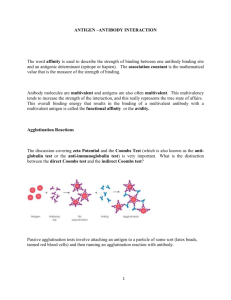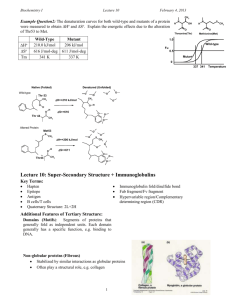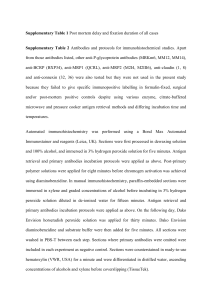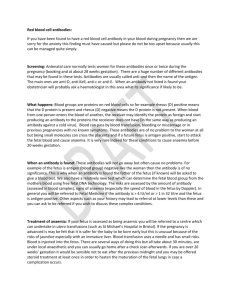Antibodies, versatile tools in research - Bio
advertisement
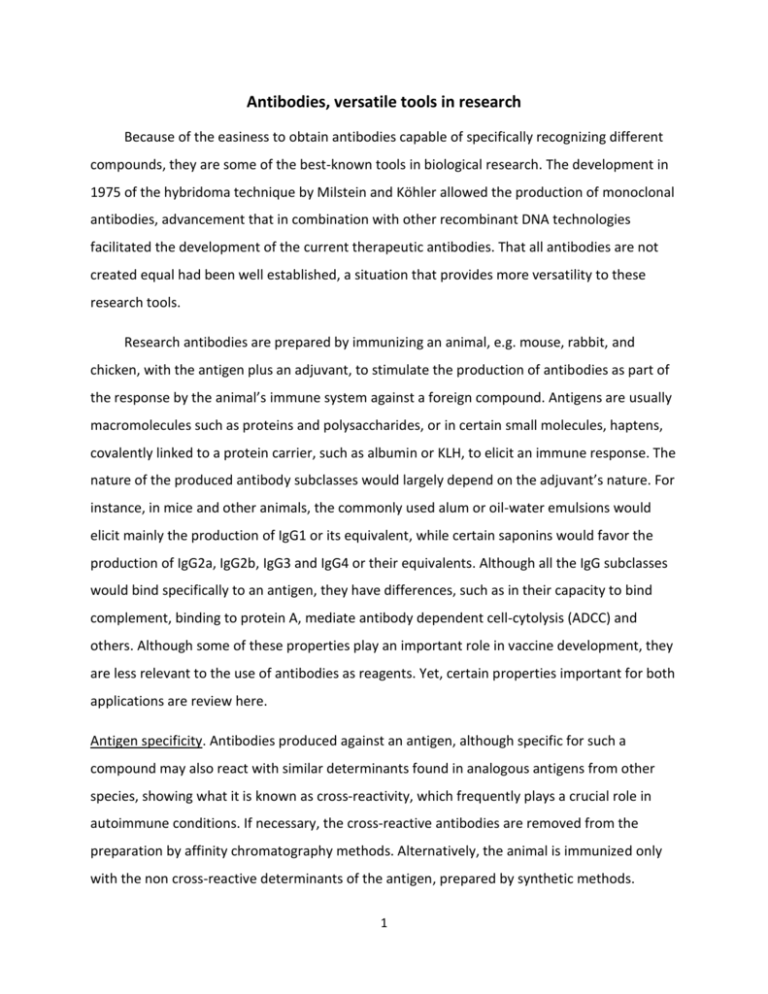
Antibodies, versatile tools in research Because of the easiness to obtain antibodies capable of specifically recognizing different compounds, they are some of the best-known tools in biological research. The development in 1975 of the hybridoma technique by Milstein and Köhler allowed the production of monoclonal antibodies, advancement that in combination with other recombinant DNA technologies facilitated the development of the current therapeutic antibodies. That all antibodies are not created equal had been well established, a situation that provides more versatility to these research tools. Research antibodies are prepared by immunizing an animal, e.g. mouse, rabbit, and chicken, with the antigen plus an adjuvant, to stimulate the production of antibodies as part of the response by the animal’s immune system against a foreign compound. Antigens are usually macromolecules such as proteins and polysaccharides, or in certain small molecules, haptens, covalently linked to a protein carrier, such as albumin or KLH, to elicit an immune response. The nature of the produced antibody subclasses would largely depend on the adjuvant’s nature. For instance, in mice and other animals, the commonly used alum or oil-water emulsions would elicit mainly the production of IgG1 or its equivalent, while certain saponins would favor the production of IgG2a, IgG2b, IgG3 and IgG4 or their equivalents. Although all the IgG subclasses would bind specifically to an antigen, they have differences, such as in their capacity to bind complement, binding to protein A, mediate antibody dependent cell-cytolysis (ADCC) and others. Although some of these properties play an important role in vaccine development, they are less relevant to the use of antibodies as reagents. Yet, certain properties important for both applications are review here. Antigen specificity. Antibodies produced against an antigen, although specific for such a compound may also react with similar determinants found in analogous antigens from other species, showing what it is known as cross-reactivity, which frequently plays a crucial role in autoimmune conditions. If necessary, the cross-reactive antibodies are removed from the preparation by affinity chromatography methods. Alternatively, the animal is immunized only with the non cross-reactive determinants of the antigen, prepared by synthetic methods. 1 BioSynthesis extensive experience in peptide synthesis would allow the design and preparation of monospecific antibody preparations. Antibody affinity. A desirable property in an antibody is a high affinity for an antigenic epitope, or the strength with which it binds to the antigen. High affinity antibodies are use in lower concentrations, minimizing the possible non-specific reactions observed with low affinity antibodies as well as the use of blocking agents. Affinity of an antibody is the resultant of several factors such as concentration of the antigen used for immunization, number of buster immunizations and adjuvant composition. Use of low antigen concentrations would favor the selection of high affinity antibodies by allowing those B-cells carrying high affinity antigen receptors on their cell surfaces to be stimulated and multiply, while those cells with low affinity receptors unable to be stimulated die; a selection process known as “affinity maturation.” This selection can be improved by the use of additional buster immunizations, usually two or three, with low antigen doses, administered every two to three weeks. In order to maximize an antigen’s capacity to stimulate an immune response, it should be administer with an adjuvant, which is an immune potentiator. Therefore, the production of antibodies in short term by using frequent immunizations with high doses of antigen would result in preparations containing mostly the less desirable lower affinity antibodies. In effect, the preparation of good antibodies is like the art of making good wine, do not rush the process. Affinity of antibodies is also increased by the phenomenon known as cooperative effect, which occurs when several antibodies bind to an antigen’s epitopes that are near to each other. In effect, the binding of an additional antibody strengthen the binding of the previously bound antibody. BioSynthesis’ antibody preparation benefits of an extensive repertoire of adjuvants as well as experience in the most suitable immunization schedules. If for special reasons preparations of high or low affinity antibodies are required, BioSynthesis has the expertise to provide those preparations using fractionation methods developed in house. Antibody titer. It is usually express as the reciprocal of the highest serum dilution that is still capable of reacting with an antigen. The titer is a reflection of the amount of antibodies and 2 their affinity. Thus, a serum preparation with a high concentration of low affinity antibodies may have a titer somewhat similar to that of a serum preparation with a low concentration of high affinity antibodies. The titer may be also a function of the experimental conditions used to determine it. For instance, a serum preparation incubated with the antigen overnight would yield a higher value than that obtained with a shorter incubation time, e.g. two hours. Thus, antibody titers should always be considered in relative terms, i.e. to compare different serum preparations processed under identical conditions. At BioSynthesis determination of titers are considered only as indicative, if a more detailed characterization is required, the actual affinity of the antibody would be determined. In addition to the preparation oh hyperimmune sera, BioSynthesis can also provide purified antibodies as well as their fragments and different conjugates, e.g. enzyme, biotinylated and fluorescently labeled conjugates, needed for immune fluorescence, ELISA and in vivo research. The company is also well-positioned to provide custom-made affinity matrices for the isolation of either antibodies or antigens. Miguel we can offer llama antibodies prepared by a collaborative effort with Peru institutions (we would get somebody there, preferentially near Iquitos where the llamas live!!). That would screw up the Belgians and Canadians because of the Biodiversity treaty. 3
